FXOpen
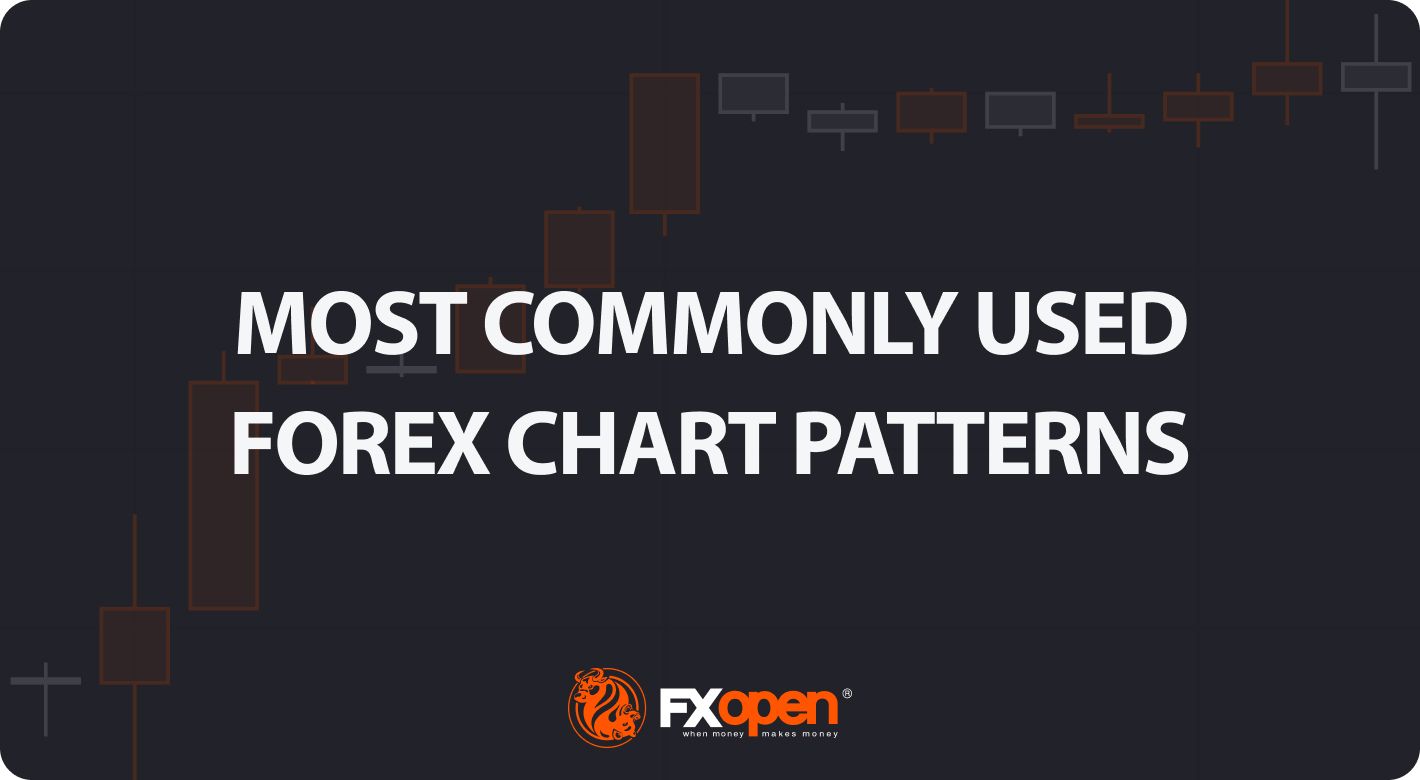
Understanding the graphic language of forex price action and recognising chart patterns may be the key to effective trading. In this article, you will learn several essential chart formations, explore their implications, and discover how you can leverage these patterns in your day-to-day trading.
Triangles
Ascending and descending triangles are common forex chart patterns that form during an uptrend and downtrend, respectively. Both are trend continuation chart patterns. There is also a symmetrical triangle, a neutral formation suggesting an imminent price breakout in either direction.
Ascending/Descending Triangle
The ascending/descending triangle consists of a horizontal line (resistance/support) and an ascending/descending line (support/resistance) that converge to create a triangle pattern. This pattern indicates that the price is likely to break to the upside or downside, respectively.
- Entry: Traders often enter a long/short position when the price breaks above/below the resistance/support level. This breakout is seen as a signal of further bullish/bearish momentum.
- Take Profit (TP): The profit target can be estimated by measuring the height of the triangle, the widest part of the formation, and adding/subtracting that value to/from the breakout point.
- Stop Loss (SL): A stop-loss order is usually placed slightly below/above the ascending/descending support/resistance line.
Symmetrical Triangle
The symmetrical triangle consists of upper and lower sloping trendlines that converge to create a triangle pattern with equal angles. This pattern suggests that a significant price movement in either direction can be expected.
- Entry: A break above the upper trendline could lead to a long position, while a break below the lower trendline might result in a short position.
- Take Profit (TP): The profit target can be determined by measuring the height of the triangle at its widest point and adding/subtracting that value to/from the breakout point.
- Stop Loss (SL): A stop-loss in a long position can be placed below the lower trendline while in a short position – above the upper trendline.
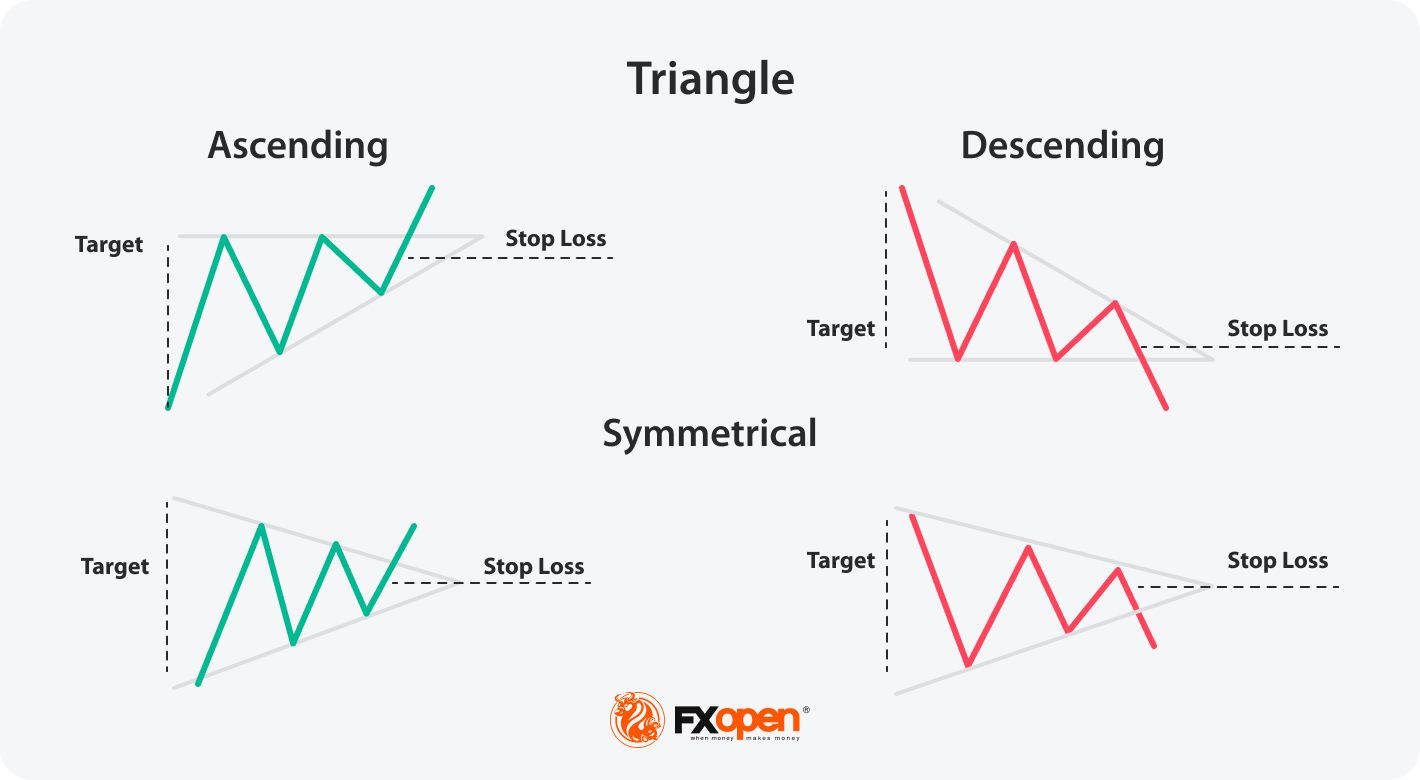
Rectangles
Bullish and bearish rectangles are continuation formations in pattern trading in forex that usually manifest during the midst of an uptrend or downtrend, respectively. They are characterised by two parallel horizontal lines that form a rectangle shape and serve as resistance and support lines depending on whether it's a bullish or bearish pattern. A price break above/below the resistance/support line suggests trend continuation.
- Entry: Traders often enter a long/short position when the price breaks above/below the resistance/support level within the rectangle.
- Take Profit (TP): The profit target can be determined by measuring the height of the rectangle and adding/subtracting that value to/from the breakout point. This gives an estimate of how far the price may move in the corresponding direction.
- Stop Loss (SL): A stop-loss order is typically placed slightly above/below the support/resistance line within the rectangle.
Flags
Bullish and bearish flags are essential in understanding how to read forex charts. These are continuation patterns appearing during an existing uptrend or downtrend, respectively. Flag patterns resemble a flag on a pole, with two parallel lines sloping downward/upward, acting as support or resistance.
- Entry: Traders often initiate long/short positions when the price breaks above/below the resistance/support level within the bullish/bearish flag.
- Take Profit (TP): For a take-profit level, traders typically measure the height of the flag pattern and project that value upward/downward from the breakout point.
- Stop Loss (SL): Traders usually place their stop-loss orders slightly below the resistance line and above the support line in bullish/bearish flags, respectively.
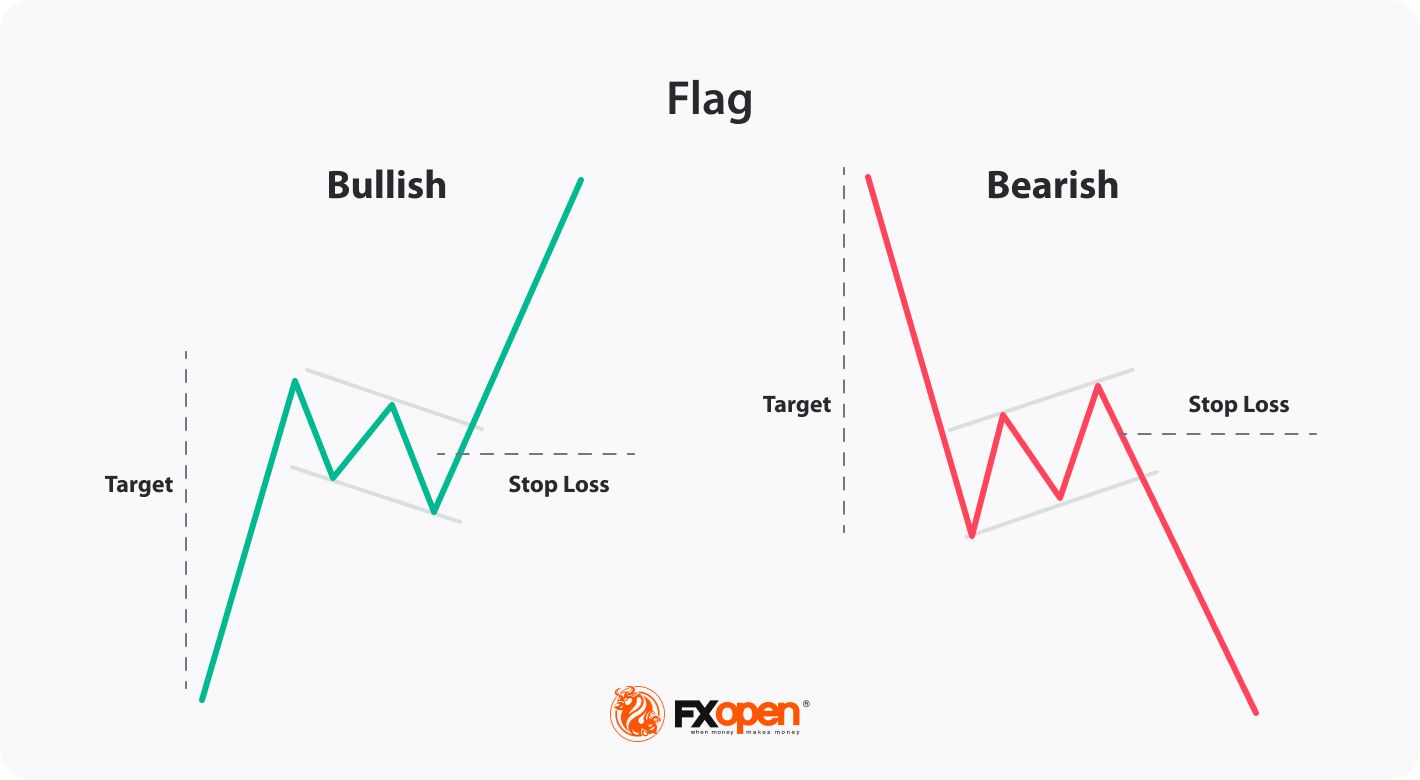
You can visit FXOpen and try out all available charting tools on our free trading platform, TickTrader.
Pennants
Traders often look for bullish and bearish pennants when trying to analyse a currency exchange chart. The pennants typically occur within an existing uptrend or downtrend, indicating a brief consolidation period before a potential trend continuation. Pennants resemble a small symmetrical triangle shape, which is defined by converging trendlines. The upper trendline acts as resistance, and the lower trendline serves as support.
- Entry: A long/short position can be initiated when the price breaks out of the pennant formation – above/below the resistance/support trendline, respectively.
- Take Profit (TP): To estimate the profit-taking point, traders usually measure the height of the pennant formation and add or subtract that value from the breakout point.
- Stop Loss (SL): Traders usually place their stop-loss orders slightly outside the pennant formation – below/above the support/resistance trendline for a long/short trade.
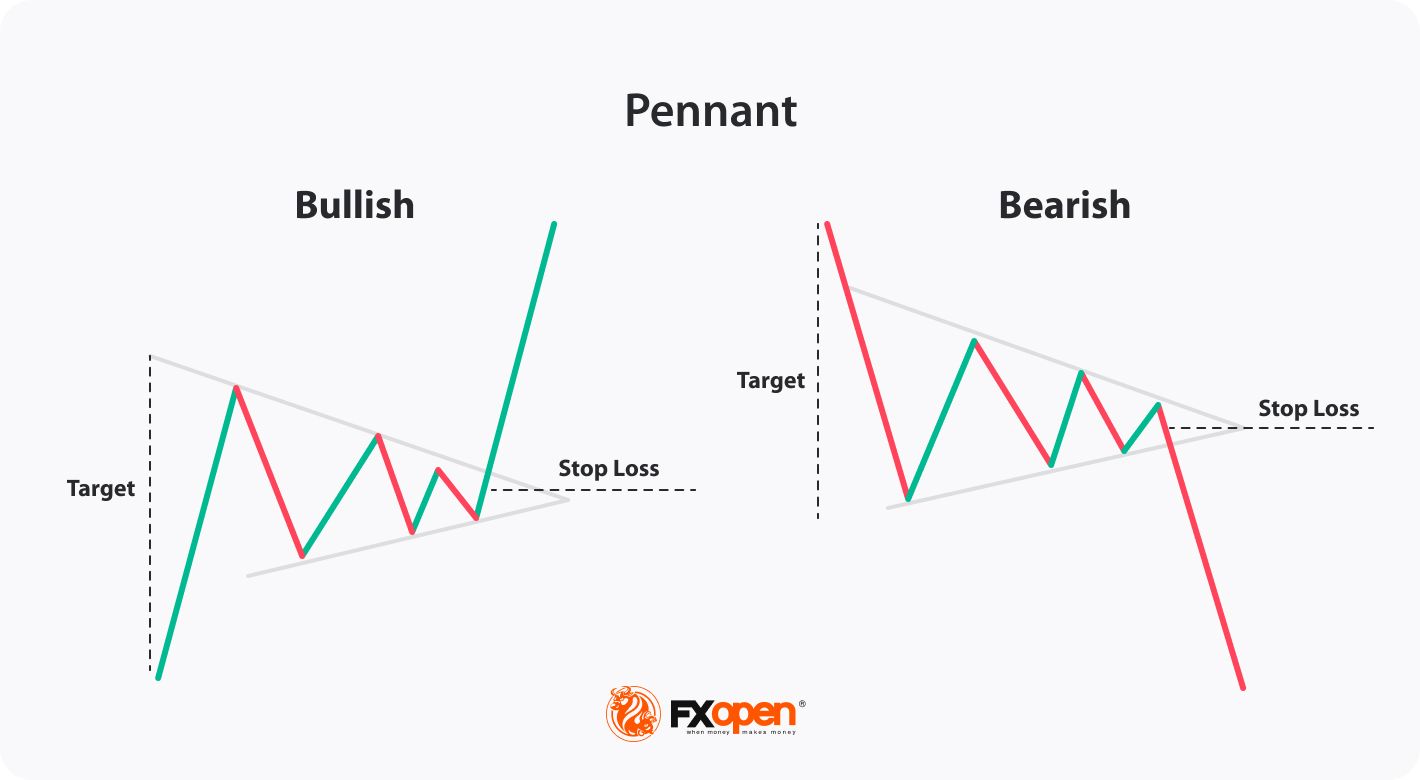
Rounding Top/Bottom
Rounding top and rounding bottom patterns are essential reversal patterns in forex trading. The rounding top is a bearish reversal pattern appearing in an uptrend, while the rounding bottom is a bullish reversal pattern appearing in a downtrend. Both patterns are characterised by a gradual curve in price action, resembling the shape of a rounded top or bottom, which signifies a shift in market sentiment.
- Entry: For the rounding top, an entry signal could occur when the price breaks below the support level formed at the bottom of the rounding curve. Conversely, for the rounding bottom, traders may consider entering long positions when the price breaks above the resistance level at the top of the rounding curve.
- Take Profit (TP): Traders may measure the height of the rounding formation and apply that measurement from the breakout point in the direction opposite to the prior trend for an estimate of how far the price may reverse.
- Stop Loss (SL): Traders usually place their stop-loss orders just beyond the breakout level.
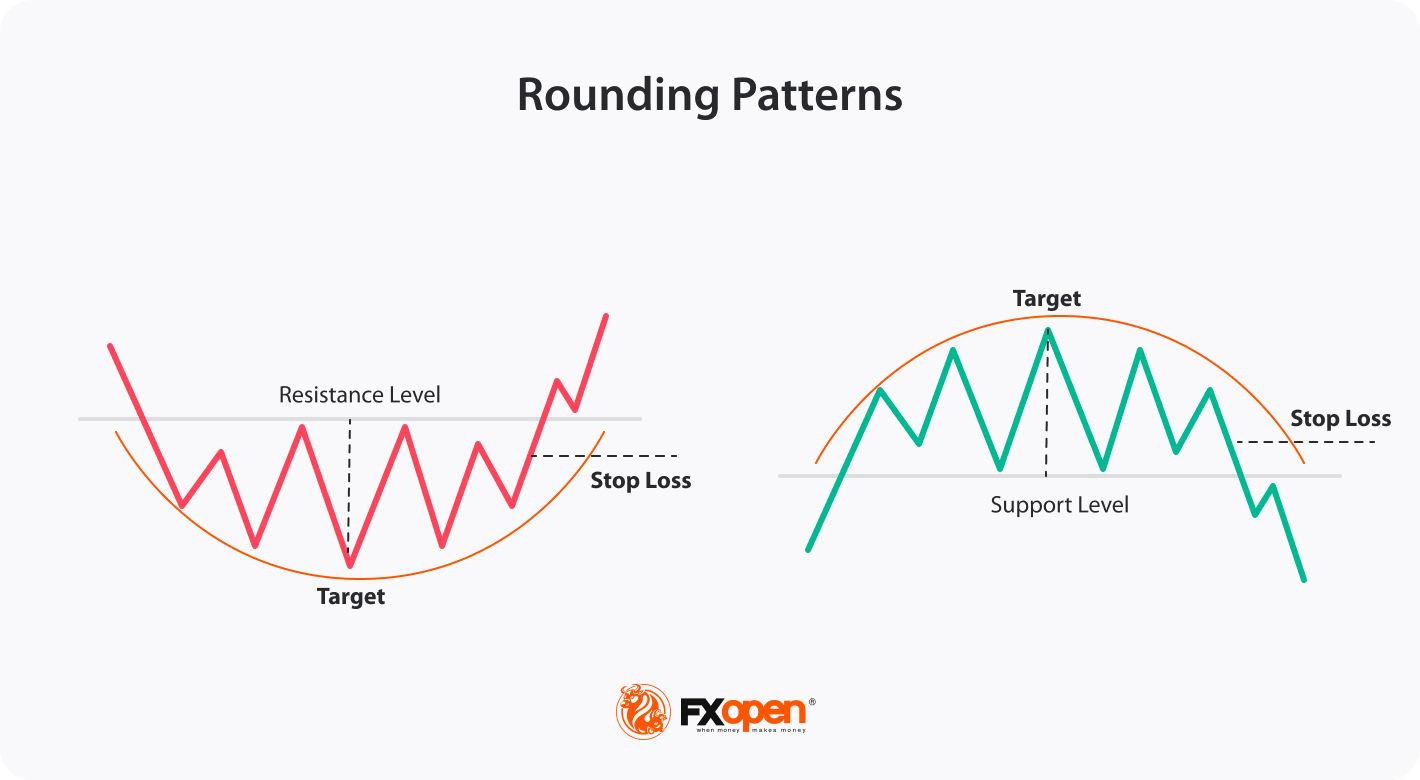
Channels
Ascending and descending channel patterns are another fundamental structure observed when analysing trading graph patterns. Channels help identify potential trends, whereby ascending channels slope upwards, suggesting bullish tendencies while descending channels slope downwards and are associated with bearish trends.
This pattern features two parallel trendlines, with the lower trendline serving as support and the upper trendline acting as resistance. The price tends to move between these lines, signifying an uptrend/downtrend, forming higher highs and higher lows and lower highs and lower lows, respectively.
- Entry: In an ascending/descending channel, traders may consider going long/short when the price bounces off the support/touches the resistance trendline.
- Take Profit (TP): If a trader opens positions within the channel, they usually target resistance in an ascending channel and support in a descending one.
- Stop Loss (SL): In an ascending/descending channel, a stop loss might be positioned below/above the support/resistance trendline.

Closing Thoughts
In the forex market, chart patterns create a picture of market sentiment, offering traders a language to interpret price action and make informed decisions. Remember, though, that while chart patterns provide valuable insights, they are most effective when used in conjunction with complementary technical analysis tools, including indicators and candlestick patterns, solid risk management, and a comprehensive trading strategy. Interested in discovering new trading prospects? Take your handy forex patterns cheat sheet and open an FXOpen account!
This article represents the opinion of the Companies operating under the FXOpen brand only. It is not to be construed as an offer, solicitation, or recommendation with respect to products and services provided by the Companies operating under the FXOpen brand, nor is it to be considered financial advice.
Stay ahead of the market!
Subscribe now to our mailing list and receive the latest market news and insights delivered directly to your inbox.









